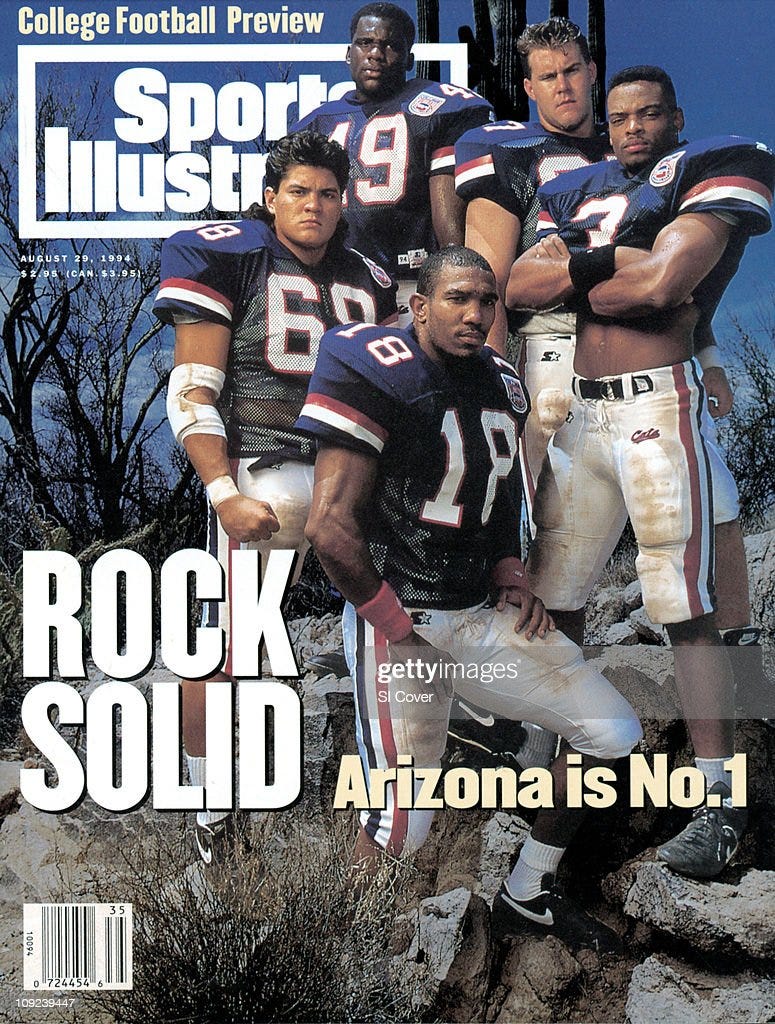Nothing Gold Can Stay
The title of this edition of The Press Break comes from a Robert Frost poem quoted in the 1983 film adaptation of the 1967 novel The Outsiders.
But to give you a sense of what a philistine I was as a teenager, my first exposure to the poem came not from Robert Frost, nor The Outsiders — at least, not directly. The scene in which Ponyboy Curtis recites “Nothing Gold Can Stay” serves as the introduction to the opening track of New Found Glory’s (fka A New Found Glory) debut album of the same name; that’s how I first discovered the poem.
Invoking a band that reached its peak of popularity in the first half of the 2000s seems a fitting jumping-off point to reminisce on the last era in which Colorado and Colorado State football were consistently competitive.
Let’s rewind a few years before the turn of the millennium to 1994. I have often cited ‘93 as the first season in which I remember really following and being engaged in college football thanks to Arizona’s Desert Swarm and Charlie Ward’s ahead-of-its-time style of play at Florida State1.
By the 1994 season, I was eager to tune in on fall Saturdays — but options were limited. NBC aired Notre Dame, ABC had its national showcase slot at noon ET and the subsequent regional broadcast2, and ESPN usually had some brutally sluggish Big Ten game. Maybe it’s Mandela Effect, but I recall seeing an abnormal amount of Indiana football on the Worldwide Leader in those days.
The tidal wave against which Justice Byron White warned in his dissenting opinion on National Collegiate Athletic Association v. Board of Regents of the University of Oklahoma hadn’t yet begun, so this was an also an era in which most Pac-10 games were relegated to the nightmare that was RAYCOM syndication3. Even more egregious was whatever syndication agreement the Western Athletic Conference had then, which resulted in the league inexplicably airing games on Prescott, Arizona’s independent Channel 7.
While Channel 7’s signal was so weak I assume it was generated via hamster wheel, I nevertheless got to see the Golden Age of the WAC as a budding football fan.
As time has passed, perception of the old WAC has come to be shaped by The Three Musketeers: BYU coach LaVell Edwards, Air Force coach Fisher DeBerry, and Wyoming coach Joe Tiller.
If Edwards, DeBerry and Tiller were Athos, Porthos and Aramis, Colorado State coach Sonny Lubick is the WAC D'Artagnan.
Edwards and DeBerry are both College Football Hall of Famers; Tiller isn’t and can’t be because of the same asininely arbitrary (arbitrarily asinine?) rules that prevent Lubick from ever gaining induction4.
However, because Tiller brought the Big Ten into the 21st Century, implementing an innovative pass attack that made undersized Drew Brees a Heisman Trophy contender and lifted previously cellar-dwelling Purdue to the 2001 Rose Bowl Game, he established a legacy remembered today as fondly as the illustrious careers Edwards and DeBerry enjoyed at BYU and Air Force.
Lubick’s legacy, 15 years after his retirement, doesn’t seem to have made quite the same impression as his WAC contemporaries. His Colorado State teams didn’t run an especially innovative or unique offense; CSU never had a Heisman contender in Lubick’s 15 seasons at the helm.
Instead, the Rams just went out and beat teams with a physicality befitting the university’s rugged agricultural identity. This Saturday marks 28 years to the day since Colorado State, in Lubick’s second season, went into Arizona Stadium to face No. 6-ranked Arizona.
This was that Arizona team: the one that, riding the wave of the first shutout in Fiesta Bowl with a 29-0 rout of Miami, came into 1994 with national championship hype from both Sports Illustrated and the Keanu Reeves/Sandra Bullock blockbuster Speed.
Colorado State burst Arizona’s bubble, out-swarming Desert Swarm in a 21-16 win. That was my first introduction to the Sonny Lubick-coached Rams, which as a young Wildcats fan, stung. But dammit, I had to respect it.
And starting with 1994, Colorado State began a run of seven seasons through 2003 in which the Rams broke into the Top 25, and three seasons that concluded with CSU ranked No. 17 or better.
Colorado State peaked my senior year of high school, finishing ranked No. 14 and going 10-2 in a season that culminated with a Liberty Bowl win over Louisville5.
The next year, Colorado — which I spent the previous decade viewing as a national powerhouse6 on par with Florida State, Miami, or Nebraska — dismantled the Cornhuskers in a Rivalry Week game I watched over Thanksgiving break during my first semester of college.
It may be a new millennium, but Colorado and Colorado State were just destined to continue being great; at least, that was my assumption.
Oftentimes, we tend to view the world from our formative years as Just How It Is, or Just How It Should Be. This line of thinking explains the obsession with nostalgia among my generation, Millennials, who grew up during ruinous wars and began adulthood amid the worst economy since the 1930s.
I admit my disappointment in both Colorado and Colorado State wallowing in futility, each winless this season, is probably rooted in the same longing for childhood that results in even mediocre ‘90s and early ‘00s art like Hocus Pocus getting reboots in the 2020s.
After all, I often played concurrent seasons of NCAA Football on the PSX managing both my longtime team Arizona and Colorado State. Those outstanding Lubick-coached teams of my youth are how I view the program, and I absolutely dread the thought of a nationally televised matchup on FS1 against a similarly struggling Nevada7 — they’ve come a long way from Prescott Channel 7! — being nothing more than fodder for bad, snarky jokes among self-identified Sickos.
The shame of it is that it doesn’t have to be this way!
Jim McElwain came to Colorado State in 2012, tasked with turning the program around after Lubick successor Steve Fairchild’s tenure failed to get off the ground.
McElwain’s background and career arc both mirrored Lubick’s in some key ways: Born in Montana, cut his coaching teeth in the Big Sky Conference (including a stint at Montana State), then graduated to coordinating one side of the ball for a true dynasty before relocating to Fort Collins.
And, like Lubick, McElwain gained quick success. There’s symmetry in the Rams winning 10 games and breaking into the Top 25 for the first time since the height of Lubick’s time on the 20-year anniversary of Colorado State’s breakout ‘94 campaign.
But Edwards, DeBerry and Lubick were the last of their kind: Winners at non-blue-blood programs leave when the opportunities present themselves, and those who don’t leave are urged to do so before their window closes and they’re no longer the hot name.
McElwain went on to Florida, coached the Gators to two straight SEC Championship Games, then was given the boot before his first unsuccessful season even finished.
In an alternate universe, McElwain stays at Colorado State for the 2015 season; CSU avoids the uninspiring hire of Mike Bobo (which leads to the downright malpractice that was bringing in Addazio8); and McElwain oversees a talented roster returning quarterback Nick Stevens and All-America caliber wide receiver Rashard “Hollywood’ Higgins on its way to contention for the Group of Five bid into the New Year’s Six.
But then, that’s contingent on a coach with the capacity to win like Lubick bucking the norms of today’s game by staying — and nothing gold can stay.
Given my youthful basketball obsession, that Ward played in a Seminoles backcourt with Sam Cassell and Bob Sura that reached the 1993 Elite Eight didn’t hurt in sparking my interest.
Keyshawn Johnson and J.J. Stokes were as much a part of my adolescence as Zach and A.C. Slater were for my peers.
Although the Conference badly miscalculated its leverage on finding distribution for Pac-12 Networks, I’m old enough that I feel qualified to put at least some blame on consumers for being either lazy or cheap over the past half-decade. Anyone who actually wants the P12N can access it with Sling, which is a significant upgrade from the preceding days of regional Fox Sports Network — and the FSN era from the end of the ‘90s through 2011 were a HUGE upgrade from the RAYCOM era.
The College Football Hall of Fame’s rigid career win-percentage minimum for inclusion on ballots is also behind the stonewalling of Howard Schnellenberger, arguably the most influential coach of the last half-century given he laid the foundation that turned a longtime punching bag at Miami into one of the all-time great dynasties; transformed Louisville from a program that had one foot in the grave into one successful and attractive enough to gain invitations to the Big East and later the ACC; and grew FAU from its infancy.
Lubick shares a more direct connection to the late Schnellenberger: After a stint as an assistant to Jack Elway at Stanford, the lifelong Westerner Lubick joined former Montana State colleague Dennis Erickson’s staff at Miami in 1989, six years after Schnellenberger’s ‘83 Hurricanes claimed the first of four national championships during their dynastic reign.
The combination of Lubick’s success as Colorado State’s head coach with his brief yet impactful stint as Miami’s defensive coordinator warrants Hall of Fame inclusion. Lubick coordinated two national championship-winning defenses, including the 1991 group that held opponents to 8.3 points per game behind a line featuring Warren Sapp and Dwayne “The Rock” Johnson.
Lubick’s masterpiece that season came in a 22-0 shutout of Nebraska in the Orange Bowl, sealing a share of the national championship.
Another tangential connection between Lubick and Schnellenberger.
Though I wasn’t an active observer, I was at least aware of Colorado winning a share of the national championship, then both the Miracle at Michigan and Rashaan Salaam’s Heisman campaign were front-and-center in my earliest phases as an ardent football fan.
An inherent irony of Colorado State and Nevada both being so bad this season is that first-year Rams coach Jay Norvell took over a complete rebuilding project after the disastrous Steve Addazio era, and part of his Year 1 blueprint included the influx of transfers. A number followed Norvell to Fort Collins from Nevada, contributing to the decimation of the Wolf Pack’s roster in Ken Wilson’s first year.
Another irony is that the hire of Addazio, a proverbial salting of the earth after Mike Bobo’s tenure began Colorado State’s downward trend, is an unfortunate byproduct of the Lubick era’s influence — albeit tangentially.
Urban Meyer leveraged his clout to steer CSU brass toward his longtime friend Addazio, fresh off an uninspired run at Boston College. Meyer’s meteoric rise in the profession really took off with his role coaching wide receivers for Lubick’s breakout Rams team of 1994.




